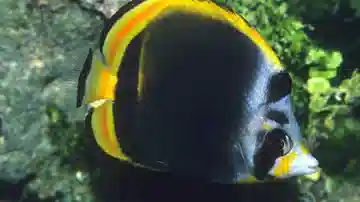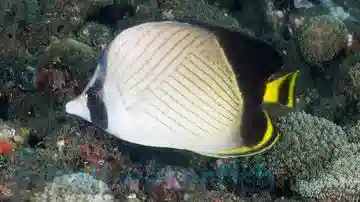Indian Vagabond Butterfly
Chaetodon decussatus
(1 Reviews)

Indian Vagabond Butterfly
Chaetodon decussatus
(1 Reviews)
{{ item.name }}
Size: {{ item.extra_field_3 }}
${{ getFormattedPrice(item.saleprice) }} ${{ getFormattedPrice(item.price) }}
To join the waiting list, click here
Free Shipping
With
$199.00
or more in Marine Life.
More details...
Indian Vagabond Butterfly Care Facts
| Care Level: | Easy |
|---|---|
| Temperament: | Peaceful |
| Diet: | Omnivore |
| Reef Safe: | No |
| Minimum Tank Size: | 100 gallons |
| Max Size: | 8 inches |
Comprehensive Guide to Keeping the Indian Vagabond Butterfly (Chaetodon decussatus) from Saltwaterfish.com
Introduction to the Indian Vagabond Butterfly
The Indian Vagabond Butterflyfish, scientifically known as Chaetodon decussatus, is a captivating species for saltwater marine aquarium enthusiasts. With its distinctive appearance and fascinating behavior, this butterflyfish can be a valuable addition to your marine aquarium. In this comprehensive product description, we will provide detailed information about keeping the Indian Vagabond Butterfly, including its habitat, reef compatibility, size, lifespan, diet in captivity, aquaculture availability, compatibility with other marine life, sexual dimorphism, juvenile to adult coloration changes, temperament, tank requirements, and specific water conditions.
Habitat of the Indian Vagabond Butterfly
Chaetodon decussatus is native to the Indian Ocean predominantly found in the waters of the Red Sea, the Arabian Sea, and the western Indian Ocean. Its natural habitat includes coral reefs and rocky substrates, where it seeks shelter among coral branches and crevices. This species is often encountered at depths ranging from 3 to 30 meters, making it well-suited for the moderate-depth marine aquarium environment.
Reef Compatibility with the Indian Vagabond Butterfly
The Indian Vagabond Butterflyfish is not considered reef-safe. While it may occasionally nip at small-polyp stony corals or clam mantles, it is regarded as a low-risk species for causing significant damage to coral reef ecosystems. Nevertheless, monitoring its behavior is crucial, as individual personalities may vary.
Size and Lifespan of the Indian Vagabond Butterfly
These butterflyfish typically reach a size of about 7 to 9 inches (18-23 cm) when fully grown. In captivity, they can live for an average of 5 to 7 years with the appropriate care and conditions.
Diet in Captivity for the Indian Vagabond Butterfly
Indian Vagabond Butterflyfish are omnivorous and feed on a varied diet in the wild, including algae, zooplankton, and coral polyps. In captivity, their diet should consist of high-quality marine flake or pellet food, supplemented with frozen or live foods like brine shrimp, Mysis shrimp, and finely chopped seafood. Offering a diverse diet will help ensure their nutritional needs are met.
Aquaculture and Availability of the Indian Vagabond Butterfly
At Saltwaterfish.com, we proudly offer aquacultured Indian Vagabond Butterflyfish to hobbyists. Aquacultured specimens are a sustainable and environmentally responsible choice, as they are bred and raised in captivity, reducing the impact on wild populations. We make it easier for you to enjoy this beautiful species while supporting conservation efforts.
Compatibility with Other Fish and Invertebrates for the Indian Vagabond Butterfly
Indian Vagabond Butterflyfish are generally peaceful but can be territorial, especially regarding their feeding areas. It is recommended to keep them with
- Yellow Tang (Zebrasoma flavescens)
- Firefish (Nemateleotris spp.)
- Royal Gramma (Gramma loreto)
- Clownfish (Amphiprion spp.)
- Blennies (Ecsenius spp.)
Sexual Dimorphism in the Indian Vagabond Butterfly
Indian Vagabond Butterflyfish do not exhibit sexual dimorphism, making it challenging to distinguish between males and females based on external characteristics.
Juvenile to Adult Coloration Changes in the Indian Vagabond Butterfly
Juvenile Indian Vagabond Butterflyfish are characterized by a striking black band that runs diagonally across their bodies. As they mature, this band may become less prominent, and the fish may develop more intricate markings, including spots and lines. Their coloration becomes more vibrant with age, making them even more visually appealing in a well-maintained aquarium.
Temperament of the Indian Vagabond Butterfly
These butterflyfish are generally peaceful and can coexist with other marine species. However, like many butterflyfish, they can become territorial during feeding, so providing multiple feeding stations and maintaining a harmonious tank environment is essential
Tank Requirements for the Indian Vagabond Butterfly
To ensure the well-being of your Indian Vagabond Butterflyfish, providing them with a suitable aquarium setup is crucial. Here are the specific tank requirements:
- Minimum Aquarium Size: A tank with a minimum capacity of 75 gallons is recommended, as these fish require ample swimming space.
- Water Conditions:
- pH: Maintain a stable pH level between 8.1 and 8.4.
- Salinity: Keep the salinity levels between 1.022 and 1.025.
- Water Temperature: Maintain the water temperature within the range of 74-80°F (23-27°C).
- Water Flow: Provide moderate water flow to mimic their natural reef environment.
Other Common Names for the Indian Vagabond Butterfly
The Indian Vagabond Butterflyfish may also be known by other common names, including the Indian Butterflyfish or Diagonal Butterflyfish.
Why Choose Saltwaterfish.com for the Indian Vagabond Butterfly
At Saltwaterfish.com, we are committed to delivering top-quality marine life for your aquarium. When you purchase the Indian Vagabond Butterflyfish from us, you can expect the following benefits:
- Expertly Aquacultured: Our Indian Vagabond Butterflyfish are aquacultured, reducing the impact on wild populations and ensuring healthier, disease-free specimens.
- Quality Assurance: We prioritize the well-being of our marine life and provide detailed care instructions to support you in maintaining a thriving and harmonious aquatic environment.
- Variety of Species: Besides Indian Vagabond Butterflyfish, we offer a wide range of marine species, allowing you to create a diverse and captivating aquarium ecosystem.
- Secure Shipping: We take great care in packaging and shipping to ensure your new aquatic addition arrives safely and in the best possible condition.
In conclusion, the Indian Vagabond Butterflyfish (Chaetodon decussatus) is an excellent choice for saltwater aquarium enthusiasts, known for its captivating appearance and peaceful temperament. When you purchase this species from Saltwaterfish.com, you enjoy a stunning addition to your marine aquarium and support sustainable aquaculture practices. Ensure their well-being by providing the appropriate tank conditions and a varied diet. With the proper care, your Indian Vagabond Butterflyfish can thrive in your saltwater aquarium for years.
I've had Indian Vagabond Butterfly for about a week and he's doing great. For the first few days I didn't see him at all, but now he makes appearances pecking at algae and darting in and out of the rocks and caves. Nice colors and appears healthy.
Reviewed by: Jason Darrow on Sept. 11, 2021



















